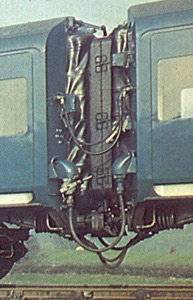Blue Pullman
Description
The sets were built to the requirements of the BTC under the general direction of Mr JF Harrison, CME British Railways Central Staff, in collaboration with Messrs SB Warder, CEE and F Grundy, Chief Traffic Officer, and the Pullman Car Company. Mr AE Robson, CMEE, LMR was responsible for inspection and test running. Mr J Howe acted as a design consultant to the Metropolitan Cammel Carriage and Wagon Co Ltd on passenger amenities and decor.
There were only five sets built, a total of 36 vehicles. They were all of an all-steel, welded construction. The LMR received two 6-car sets which had only first-class accommodation. The WR order was for three 8-car sets which contained both first and second class areas. Both the LMR & WR trains were made up of two identical half-sets. Each of the car types were given a number from 1 to 6.

| Type 1 | LMR | Motor Car |
| Type 2 | WR | Motor Car |
| Type 3 | WR | Parlour Car 2nd Class |
| Type 4 | LMR | Kitchen Car |
| Type 5 | WR | Kitchen Car |
| Type 6 | LMR/WR | Parlour Car 1st Class |
The sets were always made up in a fixed formation:
| LMR | 1 | 4 | 6 | 6 | 4 | 1 | 132 first class seats | ||
| WR | 2 | 3 | 5 | 6 | 6 | 5 | 3 | 2 | 108 first class & 120 second class seats |
All vehicles had a full width vestibule at both ends, except the kitchen end of the kitchen cars and the cab end of the motor cars.
A complete plan for an 8-car set can be found here.
Travelling technicians
A travelling technician from the Chief Mechanical & Electrical Engineer's
Department formed part of the train crew on each train. They travelled in the
leading guard's compartment, in which a small cupboard was provided for their
tools and equipment. They were responsible for:
a) deciding which of the auxiliary engines should be used;
b) changing over auxiliary engines en-route;
c) switching on the second auxiliary engine when requested by
the Pullman Car Company conductor during excessively cold weather;
d) taking action when 'fault' lights appear;
e) dealing with technical faults in traction equipment upon
request from the driver;
f) supervision of connection and disconnection of
'shore' electrical supplies, where provided, at terminating points.
Summary
Development
Press run 24/6/60
Press run 7/9/60
Staff difficulties
Ownership agreement
Manufacturer's Publicity
Description
Type 1 - LMR motor car
Type 2 - WR motor car
Type 3 - WR parlour 2nd car
Type 4 - LMR kitchen car
Type 5 - WR kitchen car
Type 6 - LMR/WR parlour 1st car
Interior
Air conditioning
Motor cars
Auxiliary power
Bogies & couplings
Brakes
Data
Sub contractors
Staff instructions
LMR services begin
LMR Publicity
LMR brochure
LMR handbills
Controversy
WR services begin
WR publicity
WR publicity brochure
WR publicity leaflet
LMR Operations
WR Operations
Liveries
Rundown & withdrawal
After service & preservation
Disposal
Maintenance Manuals
Miscellaneous
Acknowledgments & Further Reading
Images
No vehicles were preserved.


